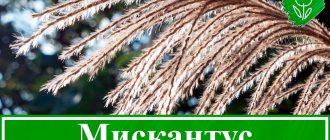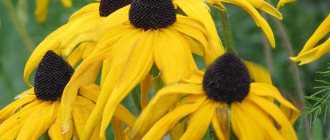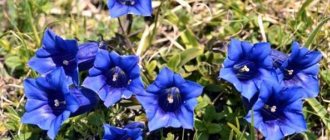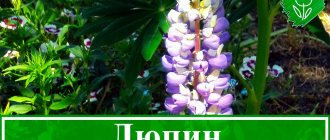Penstemon is an incredibly beautiful plant, somewhat similar to an orchid.
This is a classic perennial flower, it has pronounced frost-resistant qualities. The plant is very tall, with strong stems, large leaves of a reddish or orange hue. Flowers can be white, blue, purple, red. Luxurious racemose inflorescences of penstemons will decorate your garden from the beginning of summer until the first autumn frosts. These profusely flowering plants are mostly evergreen perennials and subshrubs. In terms of their habit, they vary from miniature cushions, common in the highlands, ideal for rock gardens, to large upright bushy forms that look good in borders and on ridges. The smallest species are best grown in raised beds. Relatively compact varieties feel great in tubs. Alpine penstemons bloom from early to mid-summer, and bedding penstemons from early summer to early autumn.
The name of the plant comes from the Greek word “penta” - five, which is due to the non-standard structure of the fifth stamen. The publication of the first scientific description of the flower dates back to 1748. Since 1900, penstemon seeds have become available for sale in European countries. About 250 species can be found in the wild in South and Central America, one of which has gone wild in the vast expanses of East Asia and the Far East.
Penstemon Description
Plants are very diverse, but they also have common features. For example, a characteristic feature of Penstemon is a rigid, twig-like vertical stem covered with oppositely arranged leathery leaves. The shape of the leaf blades varies from ovate to lanceolate. The leaves can be sessile, stalk-bending, with a wavy or smooth edge, smooth or pubescent.
Inflorescences in the form of oblong panicles are located at the tops of the stems. The color palette is varied: from shades of light pink and soft lilac to violet. White, red, yellow, blue Penstemons are often found.
Flowering lasts quite a long time. The plant blooms just when spring flowers fade, and decorates the flowerbed until autumn, sometimes until the first frost. After flowering, the fruit ripens - a capsule filled with extremely small seeds.
Penstemon got its name from the number of stamens: “pente” - five, “stemon” - stamen filament. The shape of the flowers resembles a bell with bent petals. However, there are narrow-tubular and wide-open, phlox-like flowers. For the most part they are located horizontally, in some species they are slightly directed towards the ground. Penstemon has excellent decorative properties, but is still quite rare among Russian gardeners.
General information
The Latin name of the plant translated into Russian sounds like “almost a stamen.” Due to the fact that the flower has one sterile stamen of a bizarre shape, protruding far beyond the petals, and in England penstemon is called “bearded tongue”, due to this feature.
This crop is still rare for our gardens. But due to its brightness and unusual appearance, they are beginning to grow it in our climate zone. The plant blooms in early June and flowering lasts for two to three months. It is not difficult to grow it, the main thing is to follow the advice of experienced gardeners and then the plant will delight you with its bright flowers every spring.
Types and varieties of penstemon
Penstemon Perennial
It is a herbaceous bushy perennial with straight stems and lanceolate dark green leaf blades. The height of the crop reaches 1.2 meters. Flowers can be either tubular or bell-shaped. They are collected in paniculate inflorescences, having white, red, lilac, pinkish and other colors. The plant blooms from early to late summer.
Penstemon foxglove
The advantages of the variety include its resistance to cool climate conditions. The plant tolerates winter well without additional shelter. The rosette of basal leaves does not die off throughout the year. The variety does not die at high humidity. Branched shoots reach a height of about 1.3 m. Flowering begins in June and can continue until late autumn. The flowers are characterized by a tubular shape with a creamy, pinkish tint. The most decorative species are the Evelyn varieties (pink flower with a white center, bright, green shoots). Husker red (trunks have a bright bronze hue, with white, tubular, large flowers).
Penstemon Bearded
A feature of the variety is considered to be an early, abundant onset of flowering, lasting almost two months. On bushes up to 1 m high, many very beautiful, bright scarlet flowers with a white center appear. The stems are strong, branched, the leaves are lanceolate. Blooms in May, flowering lasts until August. An example is the variety Kokkineus, which produces continuous coral-red flowers. It grows well in partial shade.
Penstemon Hybrid
It is considered a tall annual, blooming from June to September with blue bells. An example is the Anthony variety (mixture) with a friendly flowering that lasts about a month and an extraordinary aroma. With timely pruning, the bush will bloom again at the end of summer. The variety has one rhizome, which does not allow the bush to be divided. Reproduction is carried out by cuttings and seeds. It can be grown in one place for no more than four years. Very good for cutting. When sowing seeds in autumn, flowering occurs almost simultaneously with the old bushes.
Penstemon Dark Towers
The plant was developed relatively recently. It is characterized by frost resistance and abundant flowering. The leaf blades are dark burgundy, lanceolate in shape. Pale pink flowers are collected in paniculate inflorescences. The culture reaches a height of up to 70 centimeters and blooms throughout the summer.
Hartweg's Penstemon
Externally, the variety resembles the snapdragon flower. The plant reaches a height of up to 70 centimeters. The inflorescences are large, collected in unusual racemes. Shades of flowers can be white-scarlet, orange, red and purple. Flowering time lasts from mid-summer until the first frost.
Davidson's Penstemon
A low-growing herbaceous perennial, reaching a height of up to 30 centimeters. The leaf blades are medium-sized, lanceolate, green. The inflorescences are small and lilac in color. The plant blooms from early summer to mid-autumn.
Penstemon Shiny
A beautiful, low-growing (height 20 cm) flower, resistant to frost (one of the most unpretentious species), blooming with unusual blue and purple inflorescences. They appear in late spring, early summer. The plant blooms for a long time. Large flowers have a thick tube and wide petals. The lanceolate leaf rosette is painted bluish-green.
Penstemon Mystic
The plant reaches a height of up to 70 centimeters and has dark burgundy leaves and stems. The inflorescences are white, racemose with a pleasant aroma. The crop blooms from June to the end of August.
Penstemon Campanulata
The stems of the plant reach a height of up to 90 centimeters. The flowers are small, resembling bells of a pinkish-lilac hue. The leaf blades are lanceolate in shape and light green in color. The plant blooms from June to September.
Penstemon pineleaf
An evergreen bush with thin leaves, similar to pine needles, densely located on low stems (due to the abundance of flowers, they are almost invisible). The flowers are bright red (there are varieties with yellow flowers). The easiest way to propagate is by dividing the bush or cuttings grown in warm greenhouses. The plant loves peat.
Penstemon Pygmy
The variety is low-growing, reaching a height of up to 20 centimeters. Jaluzele zi – noapte. The bush has lush, dark green foliage and pubescent, lanceolate leaf blades. Racemose inflorescences of a pale lavender hue. Flowering time is from June to August.
Penstemon Kobo
The plant has large light green leaf blades with a sharp end and tall stems reaching 120 centimeters. The inflorescences are large, racemose. They are white, white-pink, white-violet, white-red and white-purple.
Penstemon Ice Cream
The variety reaches a height of up to 80 centimeters and has tall woody stems. The leaves of the plant are green, with a sharp end. The flowers are large, cream-colored, with a purple center and streaks. The plant blooms from June to September.
Penstemon Whitish
In its natural habitat it prefers rocky soil. It reaches a height of no more than 30 cm. White tubular-shaped flowers with rare purple splashes or stripes are complemented by grayish-green foliage. Flowering occurs in early June and lasts about 2 months. Due to the characteristics of the natural habitat, this species is perfect for planting on an alpine hill, rock garden or other compositions using crushed stone or limestone.
Features of flowering
Penstemon bushes begin to bloom in early June. Dense inflorescences are collected in spectacular apical brushes, the color of which can be different:
- red;
- white;
- pink;
- orange;
- purple;
- yellow;
- blue.
The petals of some species have complex colors. The duration of flowering depends on the plant variety. Often tubular or bell-shaped flowers appear in the first ten days of June and persist until mid-autumn. Then, two-leaf dense boxes with miniature seeds are formed, which can be used for sowing for two years. The seed size is so small that 1 g contains almost 10,000 seeds.
Growing penstemon
Penstemon is propagated by seed and vegetative methods. Plants are quite unpretentious and easily tolerate any manipulation. Growing penstemon from seeds begins at the end of February. You must first obtain seedlings. The seeds are distributed on the surface of sandy-peat soil in boxes and placed in a well-lit, warm room. You can sprinkle small seeds with sand. The soil must be sprayed regularly to ensure the surface is always moist. Shoots appear in 10-14 days. Seedlings are grown at a temperature of +18…+24°C. When two true leaves appear, the seedlings dive into separate peat pots. With these pots, the seedlings are planted in open ground at the end of May.
In the southern regions, they practice sowing penstemon seeds directly into open ground. It is better to do this in November, then the shoots will appear in early spring and flowering will occur somewhat earlier than with spring sowing.
A large penstemon bush can be divided into several parts. To do this, at the beginning of spring, you need to dig up the entire clump, remove most of the soil and disassemble the stems with your hands. The cuttings are planted in renewed soil at a distance of 35 cm. In May-August, cuttings are practiced. To do this, you need to cut the apical shoots without flowers and root them in moist soil. The seedlings are sprayed, covered with film and left in partial shade.
Penstemon can be propagated by layering. In spring, some shoots are partially buried into the soil using a slingshot. After 2-3 weeks, the sprout will form its own rhizome and can be separated from the mother plant.
Content
- General information
- Penstemon varieties and types of photos with names
- Penstemon planting and care in open ground
- Watering penstemon
- Soil for penstemon
- Penstemon transplant
- Penstemon fertilizer
- Penstemon flowering
- Penstemon pruning
- Preparing penstemon for winter
- Penstemon growing from seeds
- Penstemon propagation by cuttings
- Penstemon propagation by layering
- Penstemon propagation by dividing the bush
- Diseases and pests
- Conclusion
Penstemon care
Plants love sunny open glades, but are afraid of drafts and strong gusts of wind. Penstemon is planted on loose, well-drained soils with an acidic reaction. Before planting, the soil is carefully dug up and generously filled with rotted manure. Heavy soils must be mixed with sand, pebbles and sawdust.
It is necessary to regularly weed and loosen the soil so that air penetrates to the roots. Penstemons do not tolerate flooding of the soil and stagnation of water at the roots. For this reason, plants are covered for the winter, and excess snow is also removed so that excess liquid does not accumulate when melting.
Water the plants regularly, but so that the surface of the soil dries out between irrigations. In summer, watering is done every other day. On fertilized soils, the penstemon bush grows much stronger and blooms more profusely. It is recommended to use organic fertilizers, which are applied at least three times a year. A few days before flowering, penstemon is additionally watered with a solution with a high phosphorus content.
The flower must be trimmed regularly. After flowering is completed, faded inflorescences are removed. Dry leaves are also periodically cut off. In autumn it is time for radical pruning. Almost the entire above-ground part is removed, sometimes leaving a rosette of basal leaves. Every 3-5 years, even with proper care, the shoots become elongated and bare, and the inflorescences become smaller. Therefore, the bushes should be rejuvenated, replacing them with new cuttings or seedlings.
Requirements for planting site and soil
Penstemons are not too picky about where they plant. However, they do not like too wet, shady areas; unfavorable conditions cause a lack of flowering and numerous diseases. For them you need to prepare a well-lit area, carefully dug up by the sun.
The soil for penstemons should be:
- well drained;
- sandy;
- rather poor than fertile;
- optimally with a neutral pH.
Drainage or a mixture of sand and gravel is very advisable, but compost is not necessary, as it can shorten the life of the plant.
Reproduction of penstemon
Seed propagation of penstemons is very effective. These plants produce a large number of small seeds (up to 10 thousand in 1 gram), which remain viable for 2 years. Sowing seeds for flowering in the year of sowing can begin in February, but it is optimal to sow in March. Seeds are sown for seedlings on the surface of the soil, almost without covering, and germinated under film or glass in the light at a temperature of +18+22°C. Seeds of perennial species are subjected to monthly cold stratification at +5°C.
The soil should be moist, but not wet. Overdrying should not be allowed, otherwise the seeds will not germinate or the seedlings will not appear smoothly. Germination occurs within 1-3 weeks, depending on the species. After the first true leaves appear, the temperature of the plants is reduced to +16+18°C and the soil moisture is reduced, and the seedlings are protected from direct sunlight. Night temperatures are permissible within +10+15°C. Penstemons usually show very good germination.
Seedlings are planted in open ground at the end of May. There is no need to rush to land it. Seedlings of annual penstemons do not tolerate frost at all, and flowering will not be accelerated due to early planting, but, on the contrary, will be delayed.
Perennial penstemons are often propagated vegetatively, since seed propagation does not guarantee the preservation of valuable characteristics of the variety. In the spring, after awakening, the plants can be divided. Penstemons are short-lived plants (young plants) that require renewal every 3-5 years.
Not all species reproduce by division; it depends on the structural features of the root system. Therefore, you should pay attention to the methods of reproduction of a particular species. Small-stemmed species and shrubs have a compact root system; they are propagated by stem cuttings, which are separated in the spring, at the beginning of regrowth, and rooted in a greenhouse. In summer, plants can be propagated by green cuttings 10-12 cm long. However, spring cuttings are more reliable, as they give more time to prepare plants for winter. Rooting of cuttings begins within 2 weeks, and at the end of summer many of them will already bloom. Plants grown from cuttings need shelter during the first winter.
If there is a cool, bright room for wintering, then you can also take cuttings from heat-loving species grown as annuals (hybrid penstemon, Hartweg). They are cut from August and the rooted plants are placed in pots in a greenhouse or on an insulated loggia. In spring they grow at a temperature of +15+20°C. You can do it differently - save the selected queen cells, cutting them to 3 leaf nodes, and cut them in the spring. In any case, the effort is worth it, because cuttings bloom a month earlier than those grown from seeds.
Buying seeds
Since penstemon seeds take a long time to ripen, it is advisable to purchase them at flower shops.
Table 2. Signs of quality seeds, based on data provided by the supplier
PositionDescription
| Name | It is desirable that, in addition to the name, it reflects the characteristics of the culture. For example, if the plant is a hybrid, the F1 or F2 marking must be present. In addition, it is welcome to have information about the variety, necessary agrotechnical measures and care features. |
| Contact details | Availability of the full address and telephone number of the manufacturer. |
| % germination | You should not trust information about 100% germination of seeds. In the climatic zones of the Russian Federation, with the exception of southern latitudes, this is practically impossible. Indicators in the range from 80 to 95% are considered adequate. |
| Best before date | The reliable date is the one displayed in the stamp, and not the printed one. A reputable company indicates the year of seed harvest. |
| Batch number | This data is important for the buyer if he decides to purchase tested and liked seeds. In addition, the packaging must contain GOST No., according to which the sowing qualities of the product are determined. |
| Number of seeds | The exact number of seeds must be indicated, not just information in grams. |
Firebird variety
Using penstemon in garden design
The advantages of penstemons are their bright exotic flowers and long flowering. Therefore, these plants are best used where they are clearly visible. Annual and tall perennial species look good in solitary plantings in groups. In mixborders they go well with mantles, echinaceas, garden geraniums, carnations, catnips, sages, mountaineers, thymes, sedum, Byzantine sedum, Louisiana wormwood, duchesne, ornamental strawberries, variegated molinia and other cereals.
Compact annuals fit well into garden beds.
Low-growing species can be planted in borders and edging paths with them. Drought resistance allows penstemons to be successfully used as container plants. Mountain species and low-growing varieties will become the highlight of a rock garden or gravel garden, or decorate a sunny slope or retaining wall. The plants are honey-bearing and attract numerous pollinators to the garden. VKontakte











